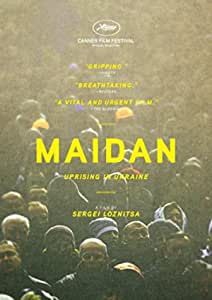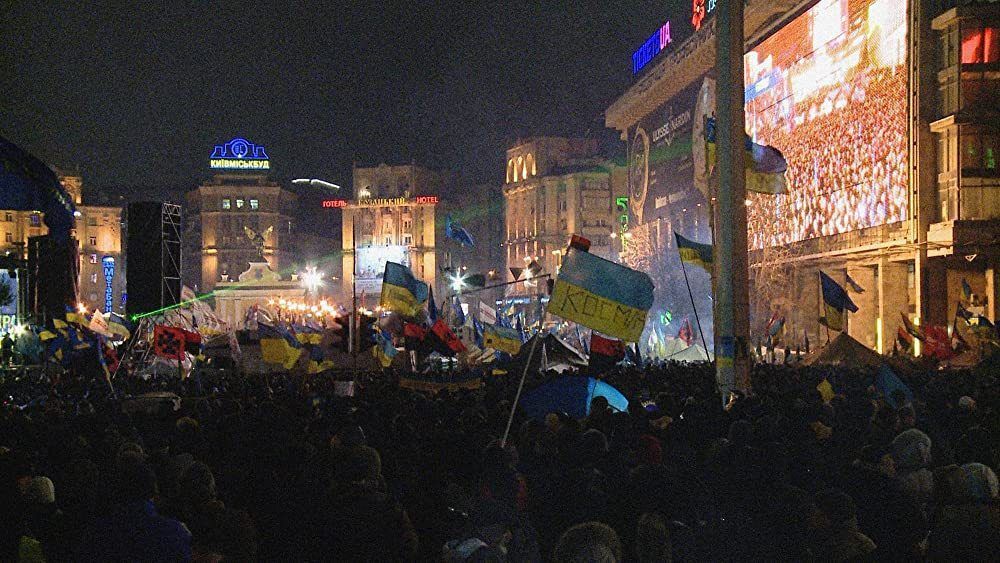Ukraine's "Independence Square" eight years ago, a brave, poetic and brilliant video work
Originally published in udn naruto hall . After the article was written, I also recorded a podcast program , and I suddenly felt a kind of confusion , "Does praising a documentary like this at this time romanticize current events, or is it appropriate to bring back emotions?" The program information is at the end of the article, and I hope to gradually enrich this part of the idea through more discussions and exchanges.
The entire Maidan documentary has been published on Youtube with English subtitles.

The special screening of the 2020 Cannes Film Festival is Hong Kong's " Revolution of the Times "; the special screening of the 2014 Cannes Film Festival is the Ukraine's Maidan (Hong Kong translated as "Independence Square").
One by one, people walked through the abandoned gates, walked through the long stairs covered with posters, painted slogans in the spacious interior, and rested on the ground covered with simple warm blankets. It was the winter of the end of 2013. The entire documentary " Independence Square " is full of motionless long shots, patiently stagnant at the scene of each Revolution in Independence Square, people passing and crossing, walking and walking, barricades, stages and musical instruments are constantly changing. The camera is fixed like a monitor, and few in the crowd look seriously at the camera, or just glance and go on.
Flow and change are the norm of the Square Revolution, and there are only two moments when the crowd calms down with the camera: once at the beginning of the film, people take off their hats and sing the national anthem in Independence Square; and at the end of the film, when the night is illuminated by the crowd’s flashlight , the coffins of the protesters were held high and pushed into the crowd one after another, and the dirge was repeated.
At first, when I saw the people in this struggle through the camera, my eyes were always a little uneasy, and my footsteps were always a little erratic. This is actually very normal in any occupation scene. People who have been on the street will definitely understand it. This kind of "truth" is rarely captured by film. Yes, leaders will speak on the stage, people of different social positions, carers of various issues, elders of various religions or social beliefs, when speaking in shifts, usually eat screws, and improvised songs by musicians usually Paint off, forget words.
People have to shout slogans, and some people have to cook and line up, and some people have to sit down and rest, and sometimes everyone seems to be weak. Maidan patiently draws a frame, and the coherent images of the editing and selection spontaneously germinate dynamic charm, flowing out various poetic interpretations.
At the beginning of 2014, the black word card simply brought out the government's absurd response measures, the protest escalated into a revolution, the Berkut troops entered a crackdown, and violent law enforcement was reckless. Independence Square, which was transformed under the thick smoke, also followed the camera to the front line, and the sound in the picture became louder and louder. In a scene of tear gas smoke and flashbang gunfire, the frame was as it was during the peaceful occupation a few months ago. , stepping on a fixed angle of view, there are various flows in the picture, but it is no longer a space for people to move freely and can look left and right; it is shields, stones, firelight, blue and yellow flags are unremittingly held high and fluttering, and the body is connected to resist . A short selected video reports the situation of the battle in a calm tone: the revolution is advancing, the revolution is retreating, and there is a tug of war.
As interviewees in " Winter on Fire: Ukraine's Fight for Freedom ," a documentary documenting the same protest movement, said the smoke created by burning a lot of tires temporarily slowed Berkut troop attack. Through "Independence Square", we seem to place a pair of eyes on the coordinates of various revolutions. When we see the firelight, we are smoked by the thick smoke. When we close our eyes, we also swallow the cold air. Then, Berkut troops and underworld-like mercenaries treated the protesters in a law-enforcement manner that violated international humanity. During the process, we saw that Ukrainians spontaneously organized themselves into volunteers and upgraded their military force.
When the crackdown began, the crowd began to resist and flee, and the camera had to shake and move. The singing had gradually changed from a light melody mocking Putin to a sad and solemn dirge. Flames and thick smoke are fixed elements. In such scenes, fireworks occasionally shoot up like ammunition. Perhaps, any fire-related items at hand must be lit. Fire is a weapon of resistance, inspiring and motivating people.

The ordinary clothes seen in the first half of the video are all simple helmets, hand-held wooden boards of different shapes, and block-shaped planes that can be used as shields in the second half. The people who hold the loud voice changed from a spiritual speech to a report of daily events, and then to calling for doctors and desperately calling for ambulance resources for the protesters who were strafed by live ammunition. After returning to the square, they turned into dispatching for the wounded. The broadcast center of resources, and finally became the master of ceremonies for mass funerals.
Later, the angle of view gradually became a little different, and I began to shoot from a relatively high place, which was probably to protect myself. Looking down, there are wounded people on the bridge who have been unable to be rescued for a long time. Even if someone directs the medical staff to enter, as soon as the protesters approach, the troops will attack. This is not a shooter, it is the repression of the Ukrainian revolution. We also saw through the camera that the protesters carried the injured people with wooden boards and wanted to flee, but they were frequently attacked, like a public mass execution. Every corner, every corner, is a cruel disaster.
People once retreated back to Independence Square. After several battles, the eyes of everyone were not only erratic unease, but despair and resentment, and they had to struggle to survive with every movement of their bodies. Suddenly, among a group of reporters standing at a high place, it was rumored that there would be a crackdown and siege. The camera of the documentary did not leave immediately, but occupied the place. After dozens of people passed through and blocked the camera, what we saw was Volunteers wore body armor, built defenses, passed bricks, and continued to defend this revolution. There is no word card description in the shady screen, only people shouting "Glory".
It was live ammunition, blocking the way out and surrounding the crowd in the square in a manner close to massacre, the most severe repression, but the film does not give this war-like image, but a ten-minute dark night of mourning, staring at People holding up the lights of their phones, staring at the stalled ambulances and the coffins to be carried out later, listening to the repeated mourning songs and "honorable" cries, listening to the silence.
The slogan "Glory to Ukraine, glory to the heroes" changed from "Glory to the heroes, the heroes never die". In the dark night, we may not be able to see every face, the silence and the hustle and bustle are neat and uniform, but the audience can understand from the images and sounds alone that during these months of revolution, the Ukrainian people in the square have experienced a collective experience. Changes brought about by trauma.
I say this is seeing a change in the Ukrainian "people" because the film is shot from the beginning to the end of the "crowd" rather than putting the camera in front of any one individual. Only the splicing between long shots, which seems simple, is in fact the whole film consistently shoots the group, and the crowd scenes that are always flowing in the frame, only highlights the calm and silent moments, the heavy and noble force. This must be the method after careful consideration and the persistence of production.
The crowd, like a living body, will change. From everyday life at the beginning of the revolution, like a peace initiative in all democracies; to the escalating repressive resistance, from passive defense to active attack, civilians turned into the appearance of volunteers; at first people lay on the ground in shifts to rest, and later people Rest forever, and around them are still the people of Ukraine.
In the end, the frame is also fixed and long, and people move around in the mourning area where flowers are placed. The audience is like a ghost at the scene, glimpsed the street group portraits at different stages of the revolution, and in the solemn and long mourning ceremony, witnessed the birth of "heroes" and the death of resistance, how to sublime into a national spirit.
This is "Independence Square" by Ukrainian director Sergei Loznitsa, a documentary about the same revolution in a very different way from "Winter Fire". The Ukrainian Film Archive put the entire film on Youtube in early March this year with English subtitles. The war is still going on, the revolution is still going on, a brave, poetic and brilliant documentary, worthy of everyone who pays attention to this war. watch.
Independence Square Documentary "Maidan": Revolution and War in Ukraine Eight Years Ago
【Apple Podcast】
https://tinyurl.com/2yux7pz5
【Spotify】
https://tinyurl.com/2m3k38zw
【Google Podcast】
https://tinyurl.com/yrmy75c4
(00:00:00) One way to know Ukraine: Documentary
(00:12:13) In-depth introduction to Maidan
(00:27:13) Romanticizing the work/bringing back the emotion
(00:32:02) Documentary, real, and filtered knowledge
【Program Score】
For Norah - Kurtis Parks
Prayer for Ukraine
Like my work? Don't forget to support and clap, let me know that you are with me on the road of creation. Keep this enthusiasm together!





- Author
- More